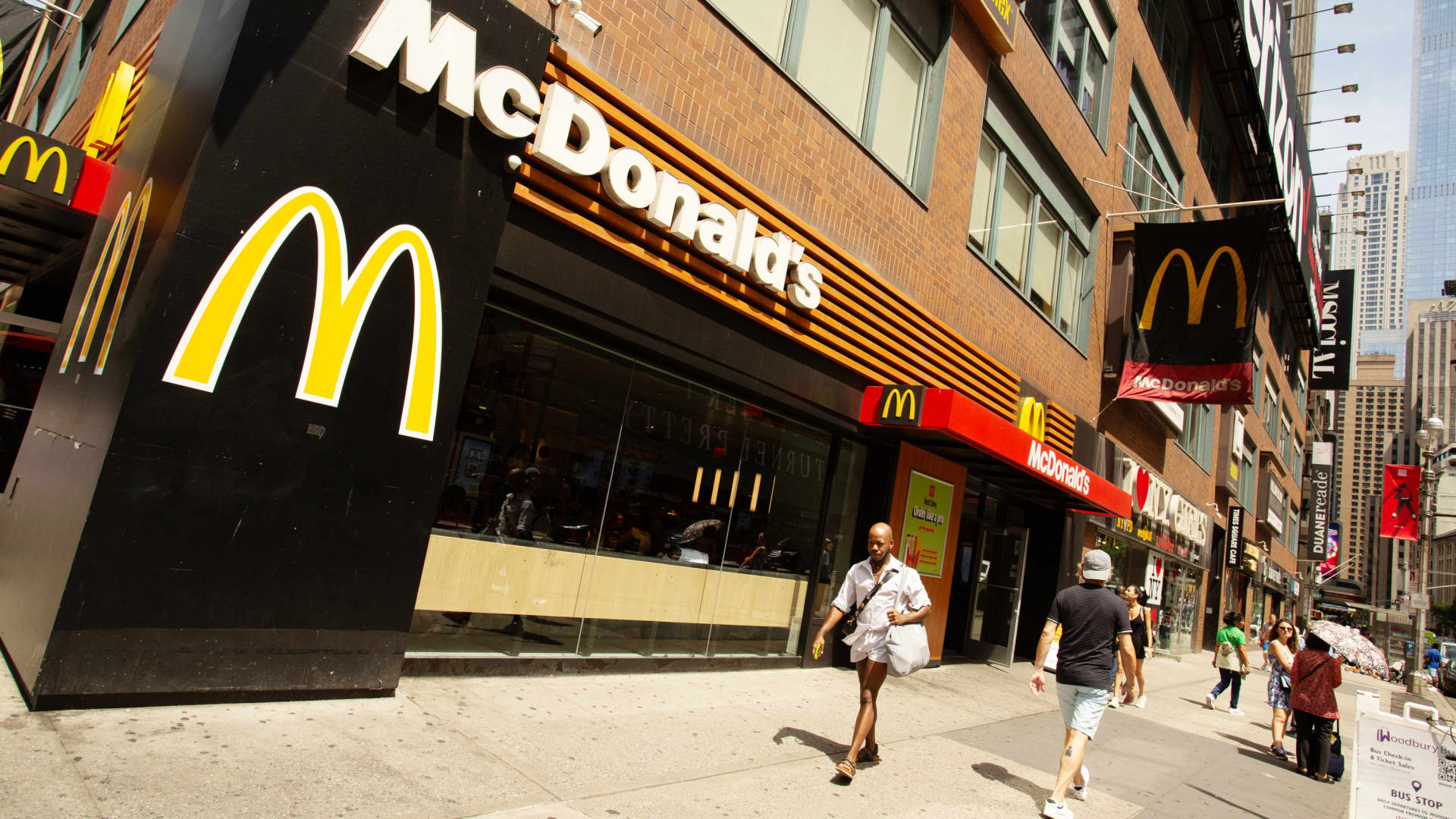3 trends are dividing restaurant companies into winners and losers
While most restaurant companies crushed earnings expectations, a number of them fell short of Wall Street's estimates for their quarterly revenue.

A McDonald's restaurant near Times Square, NYC on July 29th, 2023.
Adam Jeffery | CNBC
Restaurant companies navigating some of the same challenges in the second quarter fell into two categories: winners and losers.
Some chains said their higher menu prices alienated diners, while others said consumer behavior hasn't changed even as their food and drinks grow more expensive. Promotions drove customers to certain restaurants — or fell flat as diners focused on value. And low-income customers visited some restaurants more frequently, but skipped visits at other eateries.
Broadly, foot traffic to restaurants has fallen. Sales growth has slowed as many eateries hold off on another round of the price hikes that drove strong revenue a year ago. Customers have become more selective about how they spend their money, including where they eat, leading to a sharpening divide in chains' performance.
While most restaurant companies crushed earnings expectations, a number of them fell short of Wall Street's estimates for their quarterly revenue. McDonald's and Wingstop both reported second-quarter earnings, revenue and same-store sales growth that topped analysts' expectations, a rarity this quarter for restaurant companies.
On the other end, Papa John's, Wendy's, and Chipotle Mexican Grill were among the flock of companies that disappointed investors with weaker-than-expected sales. All three companies' stocks haven't recovered yet.
Here are three trends that defined the quarter and determined its winners and losers:
Restaurant traffic
Two metrics shape a company's same-store sales growth: how much customers spend on every order, and how often they visit the restaurant chain.
As eateries delay more price hikes and customers watch their wallets, restaurants have to rely on the second benchmark — traffic — to bolster their same-store sales. And Wall Street is watching closely.
"Investors certainly want lots of traffic as a sign of health for the concepts," TD Cowen analyst Andrew Charles told CNBC.
McDonald's, Chipotle, Texas Roadhouse and Wingstop were among the few chains that reported U.S. traffic growth in the latest quarter.
On the other end, Restaurant Brands International said U.S. traffic slipped for three of its chains: Popeyes, Burger King and Firehouse Subs. Rival Wendy's reported its domestic transactions fell 1% in the second quarter.
Looking ahead, traffic could fall even more in the second half of the year.
"And as we move through 2H23, menu pricing will likely fall fast as inflation no longer justifies the prices, and barring a rapid traffic reversal, the comps should optically fall just as fast," Barclays analyst Jeffrey Bernstein wrote in a note to clients Aug. 11. "This does not bode well for restaurant stock performance in coming months, in our view."
Value perception
Inflation is cooling, and more economists are predicting a "soft landing" rather than a recession. But consumers are still looking for value.
Broadly, the fast-food sector has benefitted from consumers trading down from fast-casual restaurants into their cheaper burgers and tacos. But consumer perception of value differs across chains.
For example, McDonald's CEO Chris Kempczinski said the chain is performing well with consumers who make less than $100,000, and with those who make under $45,000. On the other hand, Wendy's CEO Todd Penegor said the burger chain saw diners who make less than $75,000 pull back on their purchases.
Likewise, Wingstop said its customers' perception of its value is improving, coinciding with falling chicken wing prices.
"We are seeing positive trends in value scores with guests, in an environment where many brands are measuring decline," Wingstop CEO Michael Skipworth told analysts.
Fast-casual rival Chipotle has also benefited from diners' perception of its burrito bowls' value. Chipotle has seen low-income consumers return to its restaurants more than they were a year ago, CFO Jack Hartung told analysts.
Still, Chipotle's low-income customers aren't visiting as frequently as they were before inflation began accelerating. The chain has paused price hikes for now, but will decide closer to the fourth quarter if it will raise them again.
One fast-casual chain has struggled with consumers' value perception. Noodles & Company said its traffic cratered by double digits in the first part of the quarter as customers pushed back against its higher prices, which rose 13% from the year-ago period. In response, Noodles dropped its prices by 3% and pivoted its marketing to focus on value.
Promotions
As restaurants and customers focus on value, discounts and combo meals have stolen most of the marketing thunder. Limited-time menu items also helped some restaurants' sales — but weren't enough to offset weakness for others.
On one end of the spectrum was McDonald's. The burger chain's Grimace Birthday Meal fueled buzz on social media and traffic to its restaurants.
"This quarter, the theme was, if I'm being honest, Grimace," CEO Kempczinski said on the company's conference call.
The promotion featured the limited-time purple Grimace milkshake and core menu items, like the choice of a 10-piece McNugget or a Big Mac. It leaned on nostalgia for the mascot.
But not all promotions helped restaurants' top line.
For example, Papa John's released Doritos Cool Ranch-flavored Papadias for $7.99 in May. The limited-time menu item also drove social media buzz and traffic to restaurants, according to executives. However, the new Papadias couldn't compete with the chain's pepperoni-stuffed crust pizza it released a year earlier for $13.99.
"That traffic increase wasn't enough to offset check decline, and therefore you had weaker same-store sales," BTIG analyst Peter Saleh said.

 Fransebas
Fransebas 































